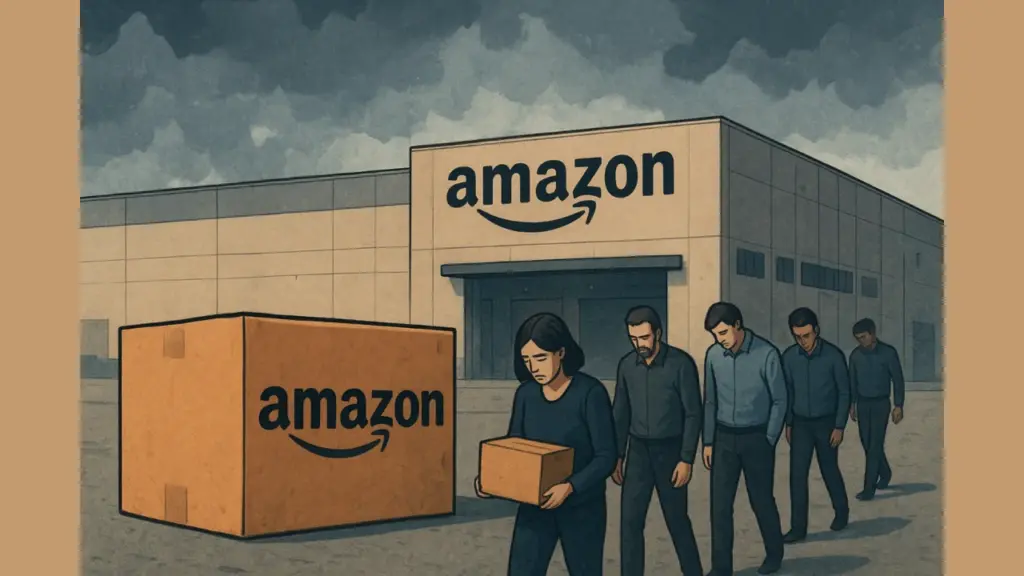1. Introduction – The Shocking Reality Behind Amazon’s Layoffs
Amazon has once again made headlines, but not for innovation or growth — this time for its sweeping layoffs. Thousands of employees across sales, marketing, and middle management were abruptly let go, as the company cited “AI efficiency” as the driving force. On the surface, this sounds like progress — artificial intelligence streamlining operations. But a closer look reveals something deeper and far less futuristic: corporate cost-cutting disguised as technological evolution.
The truth is, these layoffs had little to do with artificial intelligence and everything to do with financial strategy. Amazon’s decision raises a pressing question — are AI efficiencies being used as a convenient excuse to hide deeper management failures?
2. The Official Narrative: AI Efficiency and Cost Optimization
Amazon’s official statement painted a familiar picture. Executives claimed that artificial intelligence was transforming how teams operate, allowing for automation and smarter workflows. The layoffs, according to them, were part of a long-term shift toward “leaner, AI-powered operations.”
At first glance, it sounds like an intelligent move. Many tech companies are embracing AI to boost productivity and reduce costs. Amazon’s leaders wanted to project an image of being ahead of the curve — reshaping operations through advanced automation rather than simple downsizing.
However, when we analyze the departments that took the biggest hits — sales, marketing, and middle management — the narrative starts to fall apart. These are not areas where AI tools can fully replace human creativity, relationship management, or strategic thinking. Instead, they are areas where cost reduction has the fastest financial impact.
The question isn’t whether Amazon uses AI — it’s how it uses AI as justification for decisions driven by short-term financial pressures.
3. The Reality: Financial Pressures Behind the Scenes
Behind every tech layoff is a story of numbers. Despite record revenues, Amazon has been facing increasing costs, tighter margins, and investor pressure to boost profits. Rising logistics expenses, slowing e-commerce growth, and global inflation have all pushed the company to find new ways to maintain its market dominance.
Cutting jobs offers an immediate solution. Layoffs make the quarterly reports look better, appeasing shareholders even if they damage long-term performance. Blaming AI efficiency, however, adds a convenient layer of innovation to an otherwise routine corporate move.
From an outsider’s perspective, this strategy creates an illusion of progress — as if the company is evolving, not retreating. But internally, it sends a different message: leadership is prioritizing financial optics over people and sustainable growth.
Many industry observers, including fractional CTOs who advise startups and enterprises on tech strategy, see this as a pattern. Large corporations adopt AI buzzwords to validate decisions that are fundamentally financial, not technological.
4. The Failed RTO (Return-to-Office) Strategy
One of the biggest internal missteps Amazon made before the layoffs was enforcing its Return-to-Office (RTO) policy. The move sparked widespread employee dissatisfaction. After years of remote productivity, teams were suddenly required to return to physical offices — disrupting work-life balance and morale.
Executives claimed RTO would enhance collaboration and innovation. In reality, it created tension. Employees who had relocated or adjusted to hybrid setups felt alienated and undervalued. Productivity metrics didn’t improve, and the cost of maintaining office spaces only increased.
The RTO strategy became an expensive experiment that failed to deliver results. Instead of acknowledging this miscalculation, management doubled down by cutting teams and repositioning the decision as a shift toward “AI-driven efficiency.”
Ironically, the same company that once symbolized the future of work — digital-first, automated, and global — seemed to be stuck in outdated corporate practices.
5. Who Was Affected: Sales, Marketing, and Middle Management
When the news broke, many assumed that Amazon’s AI investments had automated warehouse or logistics jobs. But the reality was more surprising — most cuts were in sales, marketing, and middle management.
These roles are far from being automated by AI. They rely on strategy, human insight, and relationship-building. Marketing requires creativity and emotional intelligence — areas where AI can assist but not replace. Sales success depends on trust, persuasion, and understanding human behavior. Middle management connects strategy to execution, ensuring alignment between teams.
By targeting these groups, Amazon sent a troubling message. These layoffs were not about automation; they were about restructuring for profit optimization.
The employees most impacted were those who helped drive customer acquisition, maintain partner relationships, and ensure operational flow — the very backbone of Amazon’s ecosystem.
6. The Human Cost: Overworked Teams and Broken Trust
Every layoff carries human consequences. At Amazon, the emotional toll has been severe. Remaining employees face heavier workloads, constant uncertainty, and growing distrust in leadership.
Internal forums show frustration among staff who feel abandoned by the very company they helped scale. Many describe an atmosphere of “silent burnout” — working harder with fewer resources while fearing they could be next.
This erosion of trust impacts not only morale but also innovation. When employees fear layoffs, they avoid risks and stop thinking creatively. Productivity may rise temporarily due to fear-based motivation, but innovation — the soul of any tech company — takes a back seat.
For a company once hailed as a leader in operational excellence, Amazon’s human management now feels alarmingly mechanical.
7. Are These “AI Efficiencies” or Just Financial Optimizations?
Let’s be clear: AI is transforming industries. It automates repetitive tasks, provides data insights, and improves customer experiences. However, in Amazon’s case, “AI efficiency” seems less like a genuine transformation and more like corporate spin.
When a company cuts thousands of jobs in departments untouched by automation, it raises eyebrows. When the same company reports stable or rising profits shortly after, the real motive becomes obvious — boosting financial performance, not technological evolution.
Amazon isn’t alone in this approach. Google, Meta, and Microsoft have all announced similar AI-driven layoffs. In most cases, the pattern remains consistent: massive job cuts followed by stock price gains.
This trend reflects a new corporate playbook — frame layoffs as innovation, not austerity. For fractional CTOs and startup founders, this offers a valuable lesson: true AI transformation happens when technology enhances people, not replaces them.
8. The Bigger Picture: What It Means for Tech Workers
Amazon’s layoffs are part of a broader industry shift. As companies face market pressures, they’re increasingly using AI as a strategic narrative to justify internal restructuring.
For tech workers, this signals a new era where job security isn’t just about performance — it’s also about perception. Employees must demonstrate adaptability, data literacy, and a willingness to work alongside AI systems.
However, there’s a deeper concern: the erosion of trust between employees and employers. When companies use AI as a scapegoat for economic choices, they dilute the credibility of technological progress itself.
In the long run, this could slow genuine AI adoption. If employees and consumers associate AI with job loss and corporate spin, resistance to innovation will grow — undermining the very future these companies claim to build.

9. Conclusion – The AI Excuse Can’t Hide Poor Management
Amazon’s recent layoffs are not a story of artificial intelligence; they’re a story of accountability — or rather, the lack of it. The company’s leadership chose financial shortcuts over strategic problem-solving, using AI as a convenient shield to deflect criticism.
The departments hit hardest prove that this was never about automation. It was about optics. It was about Wall Street, not workforce evolution.
The lesson here extends beyond Amazon. Every business — from global corporations to emerging startups — must recognize that innovation without integrity is unsustainable. Technology should empower people, not replace them for quarterly gains.
As fractional CTOs often emphasize, AI is a tool, not a scapegoat. Companies that use it responsibly will build resilience and long-term trust. Those that don’t will face a growing backlash — from both employees and the market.
At StartupHakk, we believe in revealing these realities — where technology meets truth. Because the future of innovation doesn’t depend on how fast machines evolve, but on how wisely humans lead.




